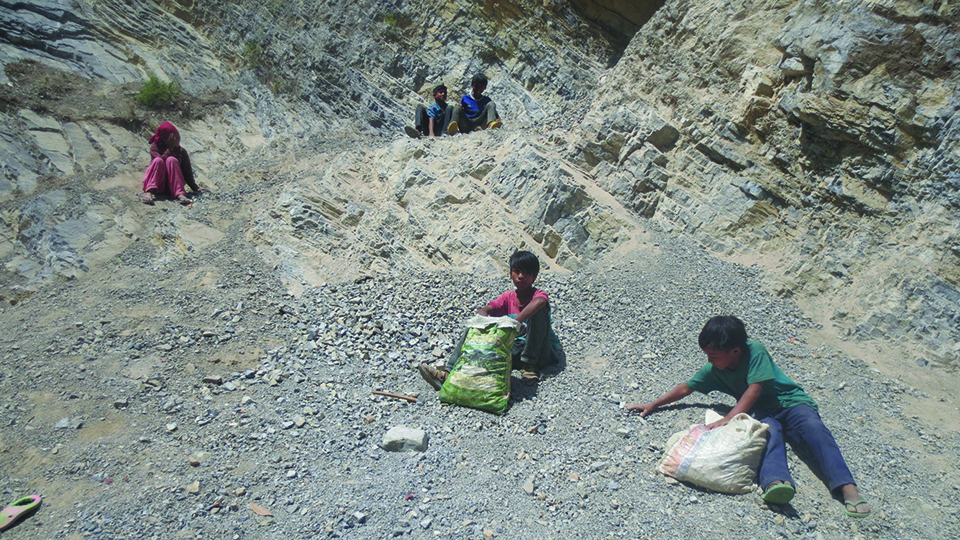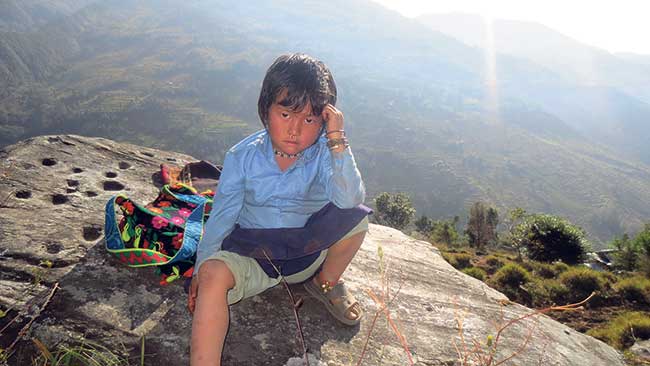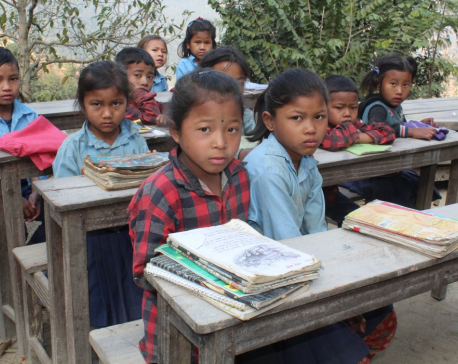
OR
Children education lagging behind in Rolpa
Published On: November 22, 2018 11:52 AM NPT By: Dinesh Subedi

ROLPA, Nov 22: Amongst the 21 community schools of Triveni Rural Municipality of Rolpa, the performance of students of 10 schools in the district level examination was very dismal last year. A total of 681 students had appeared in the district level examination from the rural municipality. Of them, only 42 students got through the test. Rest of the 291 students were given grace marks and promoted to upper grades.
This is just a glimpse into the educational scenario in Rolpa. As per the record of the District Education Office, 495 school age children are still outside of school. Even those who are enrolled in schools do not attend classes regularly. A trend of dropping out of the school is very common.
When you are struggling to meet your ends, other facilities are hardly thought of. Education for us is a luxury that only the rich and well to do families can afford for their children. Such people even send their children to better schools in cities. -- Sharada Budha of Sunchhahari Municipality, Rolpa
According to the office, 227 children are out of school in Lungri Rural Municipality alone. This municipality fares worst in terms of children's education. Similarly, Runtigadhi Rural Municipality also has a huge number of students outside of school. As per the data, 117 children of school going age are out of school.
A significant number of children in Madi, Gangadev and Sunchhahari rural municipalities are also outside of school. Many children from even the Rolpa Municipality do not go to school.
"There is lack of awareness in our villages about the importance of education. Our elders are not much worried about kids' education," said Sharada Budha of Sunchhahari Municipality. "So, even when school is nearby, some parents do not send their kids to school. When schools are far, it becomes even normal for them to do so."
However, some locals cite several problems for their inability to send their children to school. One of the main reasons they state is their inability to finance their children's education. Poverty is claimed to be the greatest hurdle. "When you are struggling to meet your ends, other facilities are hardly thought of. Education for us is a luxury that only the rich and well to do families can afford for their children. Such people even send their children to better schools in cities," Budha said.
Dan Bahadur Gurung, chief at the District Development and Coordination Committee stated that the government units have also been negligent in improving the quality of education and in tracking the progress made.
"It is true that it is not easy to bring children of Rolpa to school. When we visit schools and rural municipalities, they look reluctant to even provide us with the information. Some of the schools did not even provide us data of students that failed or passed in their exams," he said. "Concerned Rural municipalities and municipalities are also not supporting in this regard either."
According to Gurung, Smriti and Thawang rural municipalities did not provide data even after a repeated request from his office. It is the duty of the local level government to keep updated data on education, health, and other development indicators of the local population and institution. He said that these two municipalities did not provide the data stating that they didn't have the requested data.
Dil Kamal Chhetri, an official with the Save the Children, a non-profit organization, stated that the government's data on the number children presently out of school is not accurate. He said that government offices fail to produce accurate data due to the lack of serious and timely study of the scenario.
"The dropout rate is something which has to be continuously updated. Else such data is not close to reality. In lack of routine data collection, we hardly get accurate data from the government," Chhetri said. "A lot of children of school going age in Rolpa are out of school," he added.
He claimed that 495 children, which the district education office claims to be out of school are actually in a single rural municipality. If children of all villages and towns of Rolpa, who do not go to school are counted, the number is way higher then the government claims, he said. "The actual number of children out of school, as per our record is over 2.500," he stated.
Gurung said that the coordination committee is working on an action plan that aims to bring all the children to school. In coordination with the local bodies, the committee aims to identify the reasons behind children's inability to attend school and find ways to address those issues.
"We are trying to figure out how children can be brought to school and ensure that they come to school regularly. We are working in coordination with local bodies. We will put adequate pressure on the local bodies for implementing the action plan for increasing enrollement of students in schools and for lowering the drop out rates," Gurung said.
At the beginning of a new academic session, children often come to school. Many show interest in admission or readmission to school. However, gradually, they stop attending classes. "During winter or close to winter children stop coming to school. Reasons behind such dropouts should be figured out and addressed," Gurung said. "In fact, most children stop attending classes right after Dashain."
Low-income level of families has been blamed as the biggest reason for children's irregular attendance in schools. Budha says that many parents take their kids along with them to fields and construction sites for assisting them in their work. "They engage children in work as additional wages are crucial for the family to sustain," Sharada Budha said.
====
=== breaker

You May Like This

A large number of children still deprived of education in Rolpa
ROLPA, JULY 24: Twelve years old Sanjita Ghotane who lives in Rolpa's headquarters Libang, nearby the District Education Office, is deprived... Read More...

Chepang children still deprived of quality education
DHADING, Jan 23: Every morning Sonisa Chepang has to walk for two hours to reach her school. Despite her toils, the... Read More...

Increase investment in health and education of children: Demographic report
KATHMANDU, March 18: A report entitled Demographic Changes in Nepal: Trends and Policy Implications made public on Friday stressed on the... Read More...






Just In
- NRB introduces cautiously flexible measures to address ongoing slowdown in various economic sectors
- Forced Covid-19 cremations: is it too late for redemption?
- NRB to provide collateral-free loans to foreign employment seekers
- NEB to publish Grade 12 results next week
- Body handover begins; Relatives remain dissatisfied with insurance, compensation amount
- NC defers its plan to join Koshi govt
- NRB to review microfinance loan interest rate
- 134 dead in floods and landslides since onset of monsoon this year











Leave A Comment